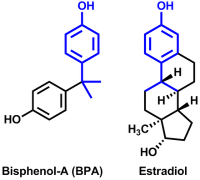 Bisphenol A
Bisphenol A (BPA) is a synthetic compound that serves as an important component in plastics. Plastics made with BPA are usually clear and tough, and can be used in a variety of common consumer goods, such as plastic water bottles, food storage containers, and certain baby bottles. Due to its versatility, an estimated 4 million tonnes of BPA-derived chemical were produced in 2015, making it one of the highest volume of chemicals produced worldwide.

For some time, BPA has been a popular topic in the media due to its undesirable effect on human health and the environment. In fact, back before BPA was every used in manufacturing, its first purported benefit was as an artificial
estrogen. Due to its chemical structure, BPA is classified as a "xenoestrogen", exhibiting estrogen-mimicking, hormone-like properties (the molecular structure of
estradiol and BPA are shown for comparison). While the effect is relatively very weak, the pervasiveness of BPA-containing materials has raised concerns.
In April 2008, the government of Canada banned the import and sale of baby bottles containing BPA, classifying it as "toxic" under the Canadian Environment Protection Act. Four years later, the United States followed suit when the FDA banned BPA from baby bottles and sippy cups. Since then, BPA-free plastics have been manufactured using alternative bisphenols such as bisphenol S and bisphenol F, but there is controversy around whether these are safer.
While many parents try to avoid BPA-products based on the
precautionary principle, many scientists hold the position that dietary exposure of adult humans should not be much of a concern due to its low toxicity, and the way that it is rapidly absorbed, detoxified, and eliminated from the human system. Others have cited studies which show insignificant amounts being passed on from a mother to the unborn offspring in rodents that were administered doses 100-1000 times higher than rates humans are typically exposed to.
Regardless of how much caution is practiced, it is almost impossible to avoid this chemical. The largest exposure humans have to BPA is by mouth from sources such as food packaging, the epoxy lining of metal food and beverage cans, and plastic bottles. Given its classification as a xenoestrogen, BPA is also classified as an "endocrine disruptor" not just in humans, but in aquatic animals. Among freshwater organisms, fish appear to be the most sensitive species. Evidence of endocrine-related effects in the growth, reproduction, and development of fish, aquatic invertebrates, amphibians, and reptiles has been reported at environmentally relevant exposure levels lower than those required for acute toxicity.
From an industrial perspective, BPA serves a vital role, and currently there is no suitable replacement. From a health standpoint, the idea of consuming synthetic chemicals, regardless of how well our bodies handle them, is not enticing for most reasonable adults. From an environmental standpoint, when BPA contaminates waterways, it harms aquatic life, and in turn, reflects back on our wellbeing. In the long run, it is our lifestyles that prevent any positive changes from occurring - unless we collectively give up on everyday conveniences, such disposable water bottles, canned goods, and plastic items, BPA will always be a necessary evil.